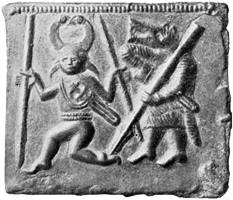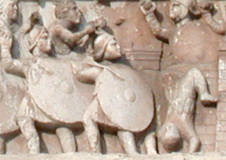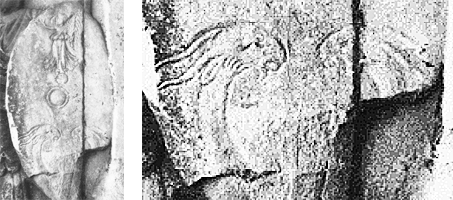
This page created 29 March 2014, and last modified: 2 November 2014 (Nakolae inscription commentary expanded)

In the eastern half of the empire, the second-most senior ranked auxilia palatina under the command of the second Master of the Soldiers in the Imperial Presence is called the Cornuti; its shield pattern as shown in various manuscripts is as below:

The shield pattern shows a yellow ground and a twin-headed zoomorphic motif that is extremely common in the Notitia (over a dozen examples), especially amongst auxilia palatina; the example borne by the Cornuti is red, and features an additional detail along the outside of "necks" of the figures: some sort of hair or feathering. What appears to be the shield boss is also rendered in a different colour, except in B: white in the two Munich (M, W) manuscripts, yellow in (P), and brown (?) in (O); the "boss" bears some sort of indeterminate markings in O, P and M, is noticeably elongated in O & P, and is absent in B.
The twin-headed zoomorphic motif is known from a range of sources in northern Europe, such as on the ca. 6th century Torslunda bronze die from Sweden shown below:

The pattern of the senior-most auxilia palatina unit in the western half of the empire, the Cornuti seniores, is similar, but not closely so, as it seems to lack the zoomorphic "heads" - other units can be found with similar patterns lacking the "heads". That labelled the Cornuti (iuniores) has no similarity, but the next unit after it, labelled the Sagittarii Nervii, is very clearly related, as it reproduces the shield of the eastern Cornuti in miniature within a border - this is one of the reasons I believe many of the western auxilia Notitia patterns are mismatched. See the following patterns taken from the Paris manuscript:

The name Cornuti is usually taken to mean "the horned ones" (though other etymologies have been advanced). The original Cornuti regiment is believed to have been one of the foremost components of Constantine I's army when he defeated Maxentius in 312, since scholars have seen the central figure shown below (amongst others) on the Arch of Constantine, completed ca. 315, as being a soldier of the Cornuti, due to his helmet decoration. The scene depicts the siege of Verona in 312; these "horns" look more like feathers to me...

This goes back to Andreas Alfoeldi, who in the early 20th century also observed that one of the men on the Arch carries a shield with the following pattern:

A winged Victory stands above the boss, while below, we see two horned creatures, possibly goats, facing each other, and with their necks curving in towards each other (and interpreted by Michael P. Spiedel in "Ancient Germanic Warriors: Warrior styles from Trajan's Column to Icelandic sagas", Routledge, 2004, as dragons). It may be that this shield pattern represents that of Constantine's original Cornuti regiment, before it was divided into eastern and western divisions.
However, this identification of the Arch figure with Constantine's Cornuti is far from sure, since it isn't known if this figure dates from the 312-315 construction date of the main arch like the above figure surely does - this one may have come from another earlier monument like other figures on the arch are known to have done.
Nonetheless, at least one regiment of Constantine's clearly did bear the zoomorphic motif, even if it wasn't the Cornuti. In the Princeton University Museum of Art is a 4th century Roman weight in the form of a small statue Constantine I; the shield clearly shows the motif, surmounted by a Christian chi-rho monogram, as shown below:

"The" Cornuti were typically brigaded with the Brachiati (Ammianus 15.5.30), and the two were famous for their rendition of the "barritus" or war-cry (Ammianus 16.12.43). Next in the list after the western Cornuti seniores in the Notitia is indeed the Brachiati seniores, whereas in the east, the Brachiati iuniores, under under the command of the first Master of the Soldiers in the Imperial Presence, appears after the (eastern) Batavi seniores. Thus it appears the eastern Cornuti was likely not the regiment present at the Battle of Strasbourg, but rather, the western Cornuti seniores.
Like the western unit, it appears the eastern unit may have been divided between seniores and iuniores at some point; epigraphic evidence (AE 1977, 806) shows that this had happened as early as 356, as an inscription of this date from Nakolea (modern Eskisehir in Turkey) reading NUMERUM IO CORN SEN has been expanded to read the "numeru[s] Ioviorum Cornutorum seniorum"; and this unit can hardly be the western Cornuti (seniores), since we know from Ammianus that the western unit was operating on the Rhine in that year. This inscription is, incidentally, the first mention known of seniores unit - see Thomas Drew-Bear (1977), available here. That the unit carries the Tetrarchic name Iovius shows that the unit had not only been in existence in Constantine's day (see M.P. Speidel, Raising New Units for the Late Roman Army (1996), available here), but was apparently raised by Diocletian in the late 3rd century. No trace of an eastern iuniores unit appears to have survived in the Notitia.

Return to the Notitia alphabetical unit list page.
Return to my Notitia index page.